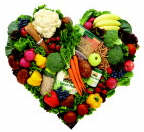Most slimmers know that fruits and vegetables are an important part of a healthy, balanced diet and can help to fill us up when we’re trying to lose weight. But nevertheless, some popular choices from the fruit and veg aisle in the supermarket still leave us feeling confused.
For example, many of us choose to avoid bananas, avocados, sweetcorn, carrots and peas because we think they are fattening. In contrast, some of us think that eating celery or grapefruit will actually help weight loss.
What’s the Truth about Fruit and Veg?
Eating more fruit and veg is essential both for good health and to help us lose weight. Most fruits and vegetables are low in calories and fat, and high in fibre – three essential ingredients for successful weight loss. Most also contain plenty of vitamins, minerals and antioxidants, all of which are important for helping us to look and feel our best and to protect us from disease.
Research also shows we tend to eat the same volume or weight of food every day, regardless of its calorie content. So if we want to lose weight, it’s crucial to stick to lower calorie foods to make up this volume. And that’s where fruit and vegetables play an important part in a weight loss diet.
Many fruits and vegetables actually weigh a lot, adding bulk to our diet, but they don't provide that many calories. For example, a meal consisting of a 150g grilled chicken breast, a 300g jacket potato, 20g of butter and 30g low fat cheese provides a total weight of 500g and provides 790 calories. Swap that meal for a 130g chicken breast, a 200g potato, 5g of butter, 80g broccoli, 45g carrots and 40g green salad, and you still have an overall weight of 500g, but for just 480 calories.
Bottom line: you will feel just as full as you’ve eaten exactly the same amount of food, but you’ve saved 310 calories – and in a week, that’s enough to help you lose 1/2lb without even changing the quantity of food you’ve eaten!
But what about foods like bananas, avocados, sweetcorn, carrots and peas? These foods are certainly higher in calories than most other fruit and veg. For example, you could eat two small apples for around the same amount of calories as a banana. Similarly, you could eat six times more spinach to provide you with the same amount of calories provided by sweetcorn.
Meanwhile, avocados are higher in fat than most other vegetables, but most of this fat is heart-healthy monounsaturates, which comes in a package with plenty of vitamin E.
Even though these fruit and veggies contain more calories, you don’t need to avoid them. They are still an important source of many different nutrients and the fibre they contain will help to fill you up so you’re less likely to want to snack on fatty and sugary foods. The key is to add them to your food diary so that the calories they provide are included in your daily total.
As for foods like celery and grapefruit, they are certainly very low in calories, but there’s no conclusive evidence that eating them will actually help you burn off calories or make you lose weight. While some studies have shown that adding grapefruit to your diet will help shift those pounds, the health jury is still out. And as for it taking more calories to digest a stick of celery than it actually provides – well, most health experts agree it’s a myth!
Which Fruit and Vegetables are Best for Weight Loss?
Enjoy a wide variety of fruit and vegetable types every day. Aim for five servings daily and choose a mixture of colours to ensure a good mix of nutrients. All fruit and vegetables, including fresh, frozen, canned, dried and pure juices, count towards the five daily servings.
But bear in mind that dried fruit won’t fill you up as much as a whole piece of fruit – for 100 calories you can eat an apple, a satsuma and seven strawberries (with a total weight of 250g) or around 1tbsp of raisins (with a weight of just 30g)! Plus, research shows that liquids tend to be less satiating than food, so you will probably find a whole piece of fruit fills you up more than a glass of fruit juice.
How Much Fruit and Veg Should I Eat?
One portion of fruit or veg is equivalent to 80g. Below are some examples of what counts as one portion:
- 1 apple, banana, pear, orange or other similar sized fruit
- 2 plums, satsumas, kiwi fruit or other similar sized fruit
- 1/2 a grapefruit or avocado
- 1 large slice of melon or fresh pineapple
- 3 heaped tablespoons of vegetables, beans or pulses
- 3 heaped tablespoons of fruit salad or stewed fruit
- 1 heaped tablespoon of raisins or sultanas
- 3 dried apricots
- 1 cupful of grapes, cherries or berries
- 1 dessert bowl of salad
- 1 small glass (150ml) of pure fruit juice
 If you have optimal heart health in middle age, you may live up to 14 years longer, free of cardiovascular disease, than your peers who have two or more cardiovascular disease (CVD) risk factors, according to a new Northwestern Medicine study.
If you have optimal heart health in middle age, you may live up to 14 years longer, free of cardiovascular disease, than your peers who have two or more cardiovascular disease (CVD) risk factors, according to a new Northwestern Medicine study.




